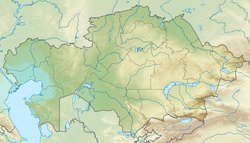Our website is made possible by displaying online advertisements to our visitors.
Please consider supporting us by disabling your ad blocker.
Bostobe Formation
| Bostobe Formation | |
|---|---|
| Stratigraphic range: Santonian-early Campanian ~ | |
| Type | Geological formation |
| Underlies | Akzhar Formation |
| Overlies | Zhirkindek Formation |
| Thickness | About 45 m (148 ft) |
| Lithology | |
| Primary | Sandstone |
| Other | Claystone |
| Location | |
| Coordinates | 45°54′N 64°42′E / 45.9°N 64.7°E |
| Approximate paleocoordinates | 38°42′N 58°00′E / 38.7°N 58.0°E |
| Region | Qaraghandy & Qyzylorda |
| Country | |
| Type section | |
| Named for | Bostobe River |
The Bostobe Formation (Kazakh: Boztóbe svıtasy) is a geological formation in Qaraghandy & Qyzylorda, Kazakhastan whose strata date back to the Late Cretaceous (Santonian to early Campanian stages, approximately 85 Ma).
The sandstones and claystones of the formation were deposited in estuarine, fluvial-lacustrine and fluvial-deltaic environments.
Dinosaur remains are among the fossils that have been recovered from the formation.[1] The formation is about 45 metres (148 ft) thick and consists primarily of clay with interbeds of sand, representing an estuarine environment.[2]
Previous Page Next Page



